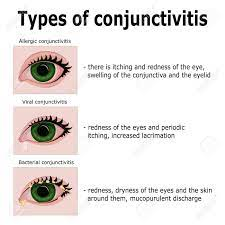Conjunctivitis, commonly known as "pink eye," is an eye condition that causes inflammation of the conjunctiva, which is the thin, transparent layer of tissue that covers the white part of the eye and lines the inner surface of the eyelid. This inflammation can lead to redness, irritation, and other uncomfortable symptoms. Conjunctivitis can affect one or both eyes and can be caused by various factors, including:
1.
Infections:
· Bacterial Conjunctivitis:
Caused by bacteria, this type of conjunctivitis often results in a sticky
discharge from the eye.
· Viral Conjunctivitis:
Typically caused by viruses like adenoviruses, it can be highly contagious and
may be associated with cold-like symptoms.
· Allergic Conjunctivitis:
Triggered by allergens such as pollen, dust, or pet dander, it usually affects
both eyes and is associated with itching and tearing.
2. Irritants:
Exposure to irritants like smoke, chemicals, or foreign objects can lead to
irritant conjunctivitis, causing redness, burning, and watering of the eyes.
This type is not contagious.
3. Allergies:
Allergic conjunctivitis occurs when the eyes react to allergens, leading to
symptoms such as itching, redness, and tearing. It can be seasonal (e.g., hay
fever) or perennial (year-round).
4. Contact Lenses:
Wearing contaminated or poorly-fitted contact lenses can lead to contact
lens-related conjunctivitis. It's crucial to practice good hygiene when using
contact lenses.
Symptoms:
The symptoms of conjunctivitis,
often referred to as "pink eye," can vary depending on the underlying
cause, whether it's bacterial, viral, allergic, or irritant-related. Here are
common symptoms associated with each type of conjunctivitis:
1. Bacterial Conjunctivitis:
·
Red
or pink appearance of the white part of the eye (sclera).
·
Eye
discomfort or irritation.
·
A
sticky or yellow-green discharge from the eye, can cause the eyelids to
stick together, especially after sleep.
·
Crusty
eyelashes upon waking.
·
Mild
swelling of the eyelids.
·
Mild
itching or burning sensation.
2. Viral Conjunctivitis:
·
Redness
of the eyes.
·
Watery
discharge that can be clear or white.
·
Tearing
or excessive eye watering.
·
Irritation
and itching.
·
Photophobia
(sensitivity to light).
·
Mild
discomfort or a feeling of something in the eye.
3. Allergic Conjunctivitis:
·
Redness
of the eyes.
·
Intense
itching, often accompanied by a strong urge to rub the eyes.
·
Watery
discharge.
·
Swelling
of the eyelids.
·
Symptoms
often affect both eyes simultaneously.
·
May
be associated with other allergy symptoms like sneezing and a runny or stuffy
nose.
4. Irritant Conjunctivitis:
·
Redness
and irritation of the eyes.
·
Burning
or stinging sensation.
·
Excessive
tearing (watery eyes).
·
Eye
discomfort or pain.
·
Symptoms
typically occur in one eye but can affect both if both eyes are exposed to the
irritant.
Treatment
Options:
The treatment for conjunctivitis, also known as pink eye,
depends on the underlying cause, which can be bacterial, viral, allergic, or
irritant-related. Here are the treatment options for each type:
1. Bacterial Conjunctivitis:
·
Antibiotic
Eye Drops or Ointments: These are often prescribed by a healthcare provider to
clear up the infection. Common antibiotics include erythromycin, ciprofloxacin,
or ofloxacin. It's important to use the medication as directed and complete the
full course even if symptoms improve.
2. Viral Conjunctivitis:
·
Supportive
Care: Viral conjunctivitis usually resolves on its own within a few days to a
couple of weeks. Supportive care may include:
· Cold
Compresses: Applying a clean, cold washcloth to the closed eyelids can help
relieve discomfort.
· Artificial
Tears: Lubricating eye drops can help soothe irritation and keep the eyes
moist.
· Antiviral
Medications: In some severe cases, antiviral eye drops or oral medications may
be prescribed, especially if the infection is caused by herpes simplex virus.
3. Allergic Conjunctivitis:
·
Allergen
Avoidance: Identify and minimize exposure to allergens, such as pollen, dust,
or pet dander.
·
Antihistamine
Eye Drops: Over-the-counter or prescription antihistamine eye drops can help
alleviate itching and redness.
·
Oral
Antihistamines: Non-prescription oral antihistamines like cetirizine or
loratadine may also provide relief.
4. Irritant Conjunctivitis:
·
Remove
the Irritant: Identify and eliminate the source of irritation, such as smoke,
chemicals, or foreign objects.
·
Artificial
Tears: Lubricating eye drops can provide relief from discomfort and help flush
out irritants.
In
all cases of conjunctivitis, regardless of the cause, it's essential to follow
these general guidelines:
·
Practice
Good Hygiene: Wash your hands frequently, especially before and after touching
your eyes.
·
Avoid
Eye Rubbing: Rubbing your eyes can worsen the condition and potentially spread
it.
·
Do
Not Share Eye Makeup or Contact Lenses: Sharing these items can transmit the
infection to others.
·
Use
Clean Towels and Pillowcases: Change and wash towels and pillowcases regularly
to prevent re-infection.
If
symptoms persist or worsen, or if you have severe eye pain, changes in vision, or
other concerning symptoms, it's important to seek medical advice promptly. Your
healthcare provider or eye specialist can provide a proper diagnosis and
recommend the most appropriate treatment for your specific case.





